Focusing on the Soft Tissue of the Body
We believe movement and an active lifestyle are key players in keeping us healthy and enjoying life, whether it’s at sports, work or playing with your grandkids. That being said, the integrity of the muscle must be restored before a rehab program can start. Above all our philosophy is for you to achieve the activity levels needed to be able to enjoy good health and moving forward in the game of life.
At Muscle Movement Therapy, instead of a pain scale, we use your improvement with the physical tasks as our guide to how well the treatment is working. These tasks may be as simple as putting on your coat, being able to lift an extra 5 pounds on your bench press, running that extra mile, or even just being able to perform your job duties with less pain or even pain-free.
Your body and you determine how many treatments it will take, not the therapist alone. Everyone is different. Two people with the same issues may respond differently to the exact same treatment. One person may only need two treatments where the other person may need five.
- Treatment sessions run up to 30 minutes long and do not require the patient to disrupt.
- Traditional massage can be either 30 or 60 minutes.
Scar Tissue
When we end up straining or over-using a muscle it causes inflammation and adhesion, or scar tissue. Continued improper movement of the muscles can cause micro-tears, which the body repairs by creating scar tissue. All of this buildup of scar tissue can lead to pain, lack of strength, and reduce joint range of motion.

OFFICE HOURS
Soft Tissue Management System
Understanding Soft Tissue Dysfunction
To understand soft tissue injury, you must comprehend the basic mechanism of cumulative injury. Cumulative trauma disorder is the major injury problem in the workforce and the general population in this country. Federal statistics show that it now surpasses back pain, and worsening by 670 percent in the last 5 years.
Symptoms of cumulative trauma disorders are sensations of tingling, burning, aching and weaknesses. When a muscle, tendon, ligament, or nerve is damaged from trauma or overuse, the body will attempt to repair the damage with scar tissue. These scar tissue adhesions left untreated perpetuate the cumulative injury cycle and result in progressive loss of function and increased pain. Soft tissue dysfunction often leads to a loss of flexibility, strength, and range of motion. People often attribute these losses to “just getting old,” but this is seldom the case.
Our treatment separates, releases, and stretches the connective tissue adhesions, restores vascular and lymph circulation, and increases your range of motion, flexibility, and strength.
The treatments can be a bit uncomfortable, or even a little painful, but this pain is an important indicator that the problem has been located and signals that the treatments are correcting the injury. Patients often report that it “hurts good.”
